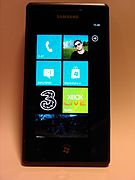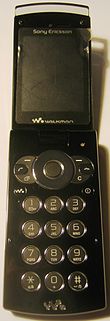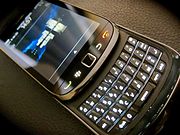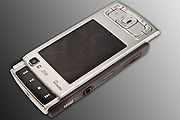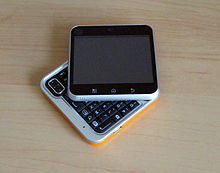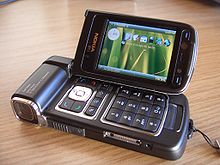- Mobile phone form factors
-
Mobile phones are designed with one of a variety of different form factors, depending on its functionality or aesthetic considerations.
Contents
Rigid form factors
Bar
A bar (slab, block, or, commonly in the United States, candybar) phone takes the shape of a cuboid.[1][2] It is named because of its resemblance to a candy bar in size and shape. This form factor is widely used by a variety of manufacturers, such as Nokia and Sony Ericsson. Bar-type mobile phones normally have the screen and keypad all on one face. The Samsung SPH-M620 is a unique take on the bar form factor, offering different devices on either side of the bar: a phone on one side, and a digital audio player on the other.
Slate
A slate phone is a subset of the bar form that, like a slate computer, has minimal buttons, instead relying upon a touchscreen and virtual QWERTY keyboard.[citation needed] Well-known slate smartphone manufacturers are Apple, HTC, LG Electronics, Samsung Mobile, and Nokia.
Moving form factors
Flip
A flip (or clamshell) phone consists of two or more sections that are connected by hinges, allowing the phone to fold or "flip" in order to become more compact. When flipped open, the phone's speaker and microphone are placed closer to the operator's ear and mouth, improving usability. When flipped shut, the phone can become much smaller and more portable than when it is opened for use.
Motorola was once owner of a trademark for the term "flip phone",[3] but the term "flip phone" has become genericized, and used more frequently than "clamshell" in colloquial speech. Motorola was the manufacturer of the famed StarTAC flip phone.
In 2010, Motorola introduced a different take on the flip phone with its Backflip smartphone. When closed, one side is the screen and the other is a physical QWERTY keyboard. The hinge is on a long edge of the phone instead of a short edge, and when flipped out, the screen is above the keyboard.
Slider
BlackBerry Torch 9800, a tall sliderA slider or slide phone is composed of usually two, but sometimes more, sections that slide past each other on rails. Most slider phones have a display segment which houses the speaker used for calls and the phone's screen, while another segment contains the keypad or keyboard and slides out for use. The goal of using a sliding form factor is to allow the operator to take advantage of full physical keyboards or keypads, without sacrificing portability, by "retracting" them into the phone when these are not in use.
The Siemens SL10 was one of the first sliding mobile phones in 1999[citation needed]. Some phones have an automatic slider built in which deploys the keypad. Many phones will "pop out" their keypad segments as soon as the user begins to slide the phone apart. Unique models are the 2-way slider (sliding up or down provides distinct functions) such as the Nokia N85 or Nokia N95.
A version of the slider form factor, the side slider or QWERTY slider, uses vertical access of the keyboard on the bottom segment. The side slider form factor is primarily used to facilitate faster access to the keyboard with both thumbs. The Danger Hiptop and the Sony Mylo are two primary examples.
Swivel
A swivel phone is composed of multiple (usually two) segments, which swivel past each other about a central axle. Use of the swiveling form factor has similar goals to that of the slider, but this form factor is less widely used.
Mixed
Some phone models use both a swivel and a flip axis, like the Nokia N90.
Brick
"Brick" is a slang term often used to refer to large, outdated bar-type phones, though it can be applied to older flip, slider and swivel phones as well.[4][5][6] Large, bulky phones such as the Motorola DynaTAC have been displaced by their newer, smaller counterparts, which offer greater portability thanks to smaller antennas and slimmer battery packs.
References
- ^ Samsung showcases T509 Slim Bar Phone; [2006-04-06]; retrieved on [2008-05-18]
- ^ 8310 Phone Review; [2007-06-08]; retrieved on [2008-05-18]
- ^ US trademark #2157939, cancelled February 26, 2005
- ^ Associated Press (2005-04-11). "First cell phone a true 'brick'". MSNBC. http://www.msnbc.msn.com/id/7432915. Retrieved 2008-05-18.
- ^ Olson, Darrin (2007-02-19). "80’s Brick Cell Phone". SlipperyBrick.com. Pragmatic Labs. http://www.slipperybrick.com/2007/02/80s-brick-cell-phone. Retrieved 2008-05-18.
- ^ "DynaTAC 8000X - the World's First Mobile Phone". h2g2. BBC. 2003-07-03. http://www.bbc.co.uk/dna/h2g2/A1082521. Retrieved 2008-05-18.
Mobile phones General Applications Application development · Application distribution · Banking · Blogging · Commerce · Content · Gambling · Gaming · Health · Instant messaging · Learning · Local search · Location tracking · Marketing · MMS · Music · News · Payment · Publishing · Push e-mail · SMS · Telephony · Text messaging · Ticketing · Web · Cloud computingCulture Devices Environmental health Law Networking Channel capacity · Frequencies · Network operators · Signal · SIM · Standards comparison · VoIP · WAP · XHTML-MP
Generations: 0G · 1G · 2G · 3G · 4G · 5GCategories:
Wikimedia Foundation. 2010.



